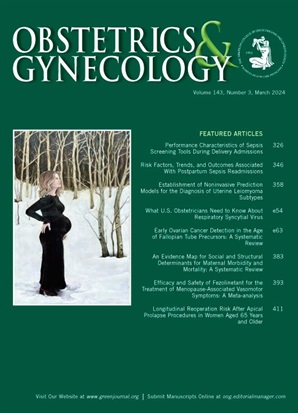慢性盆腔疼痛子宫切除术后持续疼痛的预测因素:一项系统综述。
IF 4.7
2区 医学
Q1 OBSTETRICS & GYNECOLOGY
引用次数: 0
摘要
目的系统回顾慢性盆腔疼痛患者子宫切除术后持续疼痛的相关预测因素。数据来源pubmed和EMBASE从建立到2024年7月2日进行查询,搜索调查子宫切除术治疗慢性盆腔疼痛的人类受试者研究。研究方法:由妇科外科学会系统评价组成员对慢性盆腔疼痛的研究进行双重独立筛选。我们纳入了纵向观察研究(前瞻性或回顾性)和随机对照试验(rct)。采用Cochrane偏倚风险评估工具和非随机干预研究的偏倚风险评估工具提取数据。提取由另一位研究人员进行了审查。我们对可行的效应量进行了有限的最大似然元分析。1项随机对照试验和6项队列研究符合纳入标准。研究的总体质量一般。子宫切除术后持续盆腔疼痛的发生率从12%到68%不等。年龄较小与子宫切除术后持续疼痛的可能性增加相关(总优势比[OR] 1.39, 95% CI, 1.11-1.75;5项研究,N= 11165)。卵巢保护与持续疼痛无显著相关性(OR 2.04, 95% CI, 0.67-6.18;三个研究)。子宫内膜异位症与持续疼痛有不同程度的相关性,有两项研究发现了相关性(汇总OR为1.18,95% CI为1.06-1.31),而另外两项研究发现,III期或以上子宫内膜异位症与持续疼痛无关(汇总OR为0.99,95% CI为0.45-2.21)。单个研究评估了多个感兴趣的预测因子,限制了得出综合结论的能力。结论因慢性盆腔疼痛而行子宫切除术的患者术后持续疼痛的比例较高。尽管研究设计和临床因素之间存在异质性,一些相关性需要谨慎解释,但持续盆腔疼痛与子宫切除术时年龄较小有关。系统评审注册号:prospero, crd42024530836。本文章由计算机程序翻译,如有差异,请以英文原文为准。
Predictors of Persistent Pain After Hysterectomy for Chronic Pelvic Pain: A Systematic Review.
OBJECTIVE
To systematically review predictors associated with persistent pain after hysterectomy performed for individuals with chronic pelvic pain.
DATA SOURCES
PubMed and EMBASE were queried from inception to July 2, 2024, searching for human subject studies investigating hysterectomy performed for chronic pelvic pain.
METHODS OF STUDY SELECTION
Double independent screening for studies of chronic pelvic pain was performed by members of the Systematic Review Group of the Society of Gynecologic Surgeons. We included longitudinal observational studies (prospective or retrospective) and randomized controlled trials (RCTs). Data were extracted with risk-of-bias assessment with the Cochrane Risk of Bias tool and the Risk of Bias in Nonrandomized Studies of Interventions tool. Extractions were reviewed by a second researcher. We conducted restricted maximum-likelihood meta-analyses of effect sizes as feasible.
TABULATION, INTEGRATION, AND RESULTS
One RCT and six cohort studies met the inclusion criteria. The overall quality of the studies was fair to good. The incidence of persistent pelvic pain after hysterectomy ranged widely, from 12% to 68%. Younger age was associated with increased likelihood of persistent pain after hysterectomy (summary odds ratio [OR] 1.39, 95% CI, 1.11-1.75; five studies, N=11,165). Ovarian conservation was not significantly associated with persistent pain (OR 2.04, 95% CI, 0.67-6.18; three studies). Endometriosis was variably associated with persistent pain, with two studies finding an association (summary OR 1.18, 95% CI, 1.06-1.31), whereas two other studies found that stage III or greater endometriosis was not associated with persistent pain (summary OR 0.99, 95% CI, 0.45-2.21). Multiple predictors of interest were evaluated by single studies, limiting the ability to draw aggregate conclusions.
CONCLUSION
High proportions of patients undergoing hysterectomy for chronic pelvic pain experience persistent postoperative pain. Although there is heterogeneity among study design and clinical factors examined and some associations should be interpreted with caution, persistent pelvic pain was associated with younger age at the time of hysterectomy.
SYSTEMATIC REVIEW REGISTRATION
PROSPERO, CRD42024530836.
求助全文
通过发布文献求助,成功后即可免费获取论文全文。
去求助
来源期刊

Obstetrics and gynecology
医学-妇产科学
CiteScore
11.10
自引率
4.20%
发文量
867
审稿时长
1 months
期刊介绍:
"Obstetrics & Gynecology," affectionately known as "The Green Journal," is the official publication of the American College of Obstetricians and Gynecologists (ACOG). Since its inception in 1953, the journal has been dedicated to advancing the clinical practice of obstetrics and gynecology, as well as related fields. The journal's mission is to promote excellence in these areas by publishing a diverse range of articles that cover translational and clinical topics.
"Obstetrics & Gynecology" provides a platform for the dissemination of evidence-based research, clinical guidelines, and expert opinions that are essential for the continuous improvement of women's health care. The journal's content is designed to inform and educate obstetricians, gynecologists, and other healthcare professionals, ensuring that they stay abreast of the latest developments and best practices in their field.
 求助内容:
求助内容: 应助结果提醒方式:
应助结果提醒方式:


